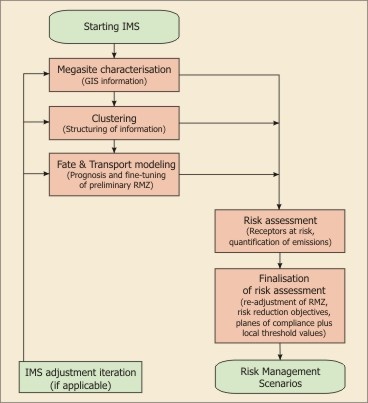Fate and effect of contaminants
The guideline given in the integrated management strategy (IMS) is based on the following steps to assess the risks caused by large-scale groundwater contamination (see figure below).
- Carry out a megasite characterization
- Define potential risk clusters
- Carry out fate and transport modelling
- Determine risks and derive local standards
- Finalize risk clusters
1. In the megasite characterization, all information relevant to a risk assessment is to be specified. This characterization is based on the developed conceptual model and should include:
- the contaminant situation
- the megasite natural systems and infrastructure
- the potential receptors
Executing this step should result in gathering all necessary data regarding the risk assessment and storing them in a structured way using a geographical information system (GIS).
2. Potential risk clusters are made which help to systematically structure the megasite. Site-specific conditions are important in the determination of risk clusters. The generic aspects of clustering are:
- estimation of pathway- and receptor-specific priority contaminants
- estimation of transfer pathways between contaminant sources and receptors
Once the potential risk clusters have been selected, a specific and detailed risk assessment for potential receptors is carried out in the following steps. Because of the IMS being a tiered approach, an adjustment of the potential clusters to final clusters takes place in the final step of this section.
3. The fate and transport modelling is carried out for each derived cluster and each potential receptor to obtain information about the tendency of the temporal and spatial behaviour of contaminants. It is based on:
- criteria of the risks for potential receptors
- reliability of the description of groundwater and contaminant transport processes
The reliability of the pollutant transport description is the base of all further assessments, and therefore needs to be discussed in detail. The IMS offers tools for making the choice of reliable models and screening methods of the contaminant situation.
4. The risks have to be determined with regard to possible mitigation measures on the basis of the modelling results. Tools for translating the modelling results into risks to specific receptors of concern are presented, and referred to, in the tool section. The site-specific standards are to be derived as a result of the risk assessment, depending on the following aspects:
- the functions of the receptors of concern
- the potential management scenarios (on a strategic level)
- the stakeholders' priority and risk perception
The standards determined for the receptors of concern serve as the input data for developing and optimising risk reduction scenarios. This is done in the next section of the IMS.
5. The risk clusters must be finalized according to the results of modelling and risk assessment. An adjustment of the potential clusters may be needed to derive the final clusters. These are the base for the development of risk reduction scenarios in next section of the IMS.
